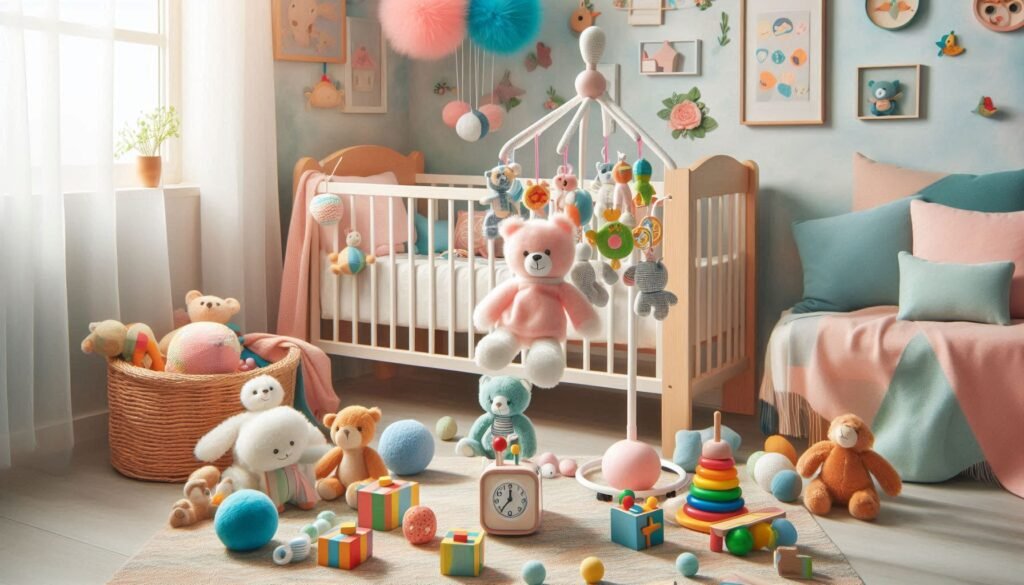Introduction to the Importance of Toys for Infants
Toys play a crucial role in the early stages of a child’s development, particularly for infants aged 0 to 1 year. During this formative period, babies experience rapid cognitive, emotional, and physical growth. Engaging with toys stimulates their senses, allowing them to explore the world around them effectively. This sensory exploration is foundational, as it lays the groundwork for future learning and development.
From the moment they are born, infants begin to process their environment through touch, sight, sound, and taste. Toys designed for young children facilitate this exploration by providing varied textures, colors, and sounds that captivate their attention. For example, rattles and soft toys encourage auditory and tactile engagement, while brightly colored objects stimulate visual perception. Through these interactions, infants enhance their cognitive abilities, as they learn to recognize patterns, differentiate shapes, and respond to stimuli.
Moreover, toys foster emotional development by promoting attachment and security. Soft plush toys or comforting blankets can serve as transitional objects that help infants develop a sense of trust and familiarity. The emotional connection formed through play with toys can be instrumental in building a secure attachment between the infant and their caregivers, reinforcing feelings of safety and love.
Physical development is equally supported through play. Toys that encourage reaching, grasping, or crawling provide opportunities for infants to practice and refine their motor skills. For instance, toys that roll can motivate a baby to crawl, thus enhancing their physical co-ordination and strength over time. In essence, through the exploration and manipulation of toys, infants engage in activities that promote holistic development.
In conclusion, toys are not merely objects for entertainment; they are vital tools that contribute to the comprehensive development of infants aged 0 to 1 year. They are essential for facilitating sensory exploration and emotional connections while also supporting physical growth and coordination.
Developmental Milestones for 0 to 1 Year Olds
Understanding the developmental milestones for infants from 0 to 1 year is crucial for new parents as it helps in selecting appropriate toys that can support their child’s growth. During the first year, babies experience rapid physical, cognitive, language, and social development, with each milestone laying the foundation for future skills.
Physically, from birth to three months, infants exhibit reflexes such as grasping and sucking while beginning to gain head control. As they approach six months, they typically can sit up with support, roll over, and may start to crawl. By the end of the first year, many babies are pulling themselves up to stand and may even take their first steps. Selecting toys that encourage physical activity, such as soft blocks and activity centers, can significantly contribute to these milestones.
Cognitively, babies begin to engage with their environment, showing curiosity and developing problem-solving skills. From three months to one year, they start to recognize faces, understand object permanence, and explore cause-and-effect relationships. Toys like stacking rings or shape sorters encourage this cognitive development, offering challenges that stimulate reasoning and critical thinking.
Language development progresses gradually throughout the first year. Infants typically coo and babble in the early months, and by the end of their first year, they may say simple words like “mama” or “dada.” Interactive toys, such as those that produce sounds or require verbal responses, can foster this crucial stage of language acquisition.
Lastly, social development is marked by bonding with caregivers and increasing interaction with others. From around six months, infants may display social smiles and preferences for familiar people. Toys that promote shared play experiences enhance these social skills. Through understanding and supporting these key milestones, parents can make informed decisions when selecting toys that contribute substantially to their baby’s development during this formative year.
Types of Toys Suitable for Newborns (0-3 Months)
Choosing the appropriate toys for newborns aged 0 to 3 months is vital for fostering early development. At this stage, babies primarily respond to visual, auditory, and tactile stimuli. Therefore, the best toys are designed to engage these senses effectively. High-contrast toys, for instance, are excellent for visual stimulation. Infants are born with limited vision, preferring bold patterns with stark contrasts, such as black and white. Soft plush toys or fabric books that incorporate these colors can captivate the baby’s attention, aiding in their visual tracking skills.
Auditory stimulation also plays a significant role in a newborn’s sensory development. Toys that produce gentle sounds, such as soft rattles or musical mobiles, can help babies familiarize themselves with different auditory cues. The soft rattles, when shaken, provide auditory feedback that encourages babies to explore their environment and notice cause-and-effect relationships. A mobile that rotates slowly above the crib can further engage a baby’s eyesight while producing soothing sounds, promoting relaxation and quiet observation.
Tactile stimulation is equally important in this early phase. Toys that are soft to the touch, with varied textures, can encourage babies to explore tactile sensations. Teething rings or squeezable toys made from safe materials are good choices. These toys help to develop grip strength, an essential part of motor development, and can be soothing for babies as they begin to teethe. Overall, selecting toys that provide visual stimulation, sound exploration, and tactile interaction will not only entertain newborns but also support their developmental milestones during these formative months.
Best Toys for Infants (3-6 Months)
At the developmental stage of 3 to 6 months, infants begin to engage with their surroundings actively. Choosing the right toys during this period is crucial to support their growing motor skills and sensory exploration. Toys designed for this age group should stimulate various senses while being safe and easy for little hands to grasp.

One of the most beneficial types of toys for infants in this age range are sensory balls. These balls can come in various textures and colors, enticing babies to explore and interact with them. The act of grasping, rolling, and even bringing the ball to their mouth helps reinforce their developing hand-eye coordination. As infants become more aware of their surroundings, sensory balls promote both tactile stimulation and coordination, which are critical elements in their early motor development.
Another essential type of toy is plush toys that are soft and easy to handle. These toys often feature vivid colors and interesting patterns that captivate an infant’s attention. When infants grasp, pull, or even chew on these toys, they enhance their developing grip and ability to manipulate objects. Furthermore, plush toys often encourage emotional bonding as babies find comfort and security in their presence.
Teething toys are also pivotal during this stage, as many infants start to show signs of teething around six months. These toys provide relief for sore gums and can be made from safe, chewable materials. Opting for a teething toy that incorporates various textures and can be chilled enhances its effectiveness by soothing discomfort while also promoting sensory exploration.
Overall, the ideal toys for infants aged 3 to 6 months are those that encourage movement, interaction, and sensory experiences. By selecting toys such as sensory balls, plush toys, and teething aids, parents can significantly contribute to their baby’s motor skill development and sensory awareness during this formative stage.
Recommended Toys for Babies (6-9 Months)
During the 6 to 9 months developmental stage, babies experience significant physical and cognitive growth, making it an ideal time to introduce toys that encourage movement and exploration. At this age, infants typically begin crawling, pulling up on furniture, and even attempting to stand. Selecting toys that support these milestones is crucial for their development.
One of the top recommendations for this age group is the activity center. These toys often feature a variety of engaging activities that require babies to reach, grasp, and manipulate objects. Activity centers can promote coordination and fine motor skills while encouraging physical movement as babies shift their weight to explore different sections. Some designs include interactive elements like spinning knobs or musical components that capture an infant’s attention, enhancing cognitive engagement as well.
Stackable toys, such as rings or cups, are another excellent choice. These toys challenge babies to experiment with balance and spatial awareness as they learn to stack objects in a stable manner. This interaction not only fosters problem-solving skills but also serves as a delightful playtime activity that can be enjoyed individually or with a caregiver. The colors and textures of stackable toys provide sensory stimulation, making them both educational and entertaining.
Additionally, pull-up toys can offer significant support for babies who are attempting to stand. With stable bases and easy-to-grip handles, these toys encourage infants to practice standing and walking while ensuring safety. As they pull themselves up, they develop leg strength and stability, integral elements in their physical development.
Ultimately, choosing toys that align with the developmental abilities of babies aged 6 to 9 months can foster essential skills. Engaging with activity centers, stackable toys, and pull-up toys contributes significantly to coordination, balance, and problem-solving, ultimately supporting an infant’s growth journey.
Ideal Toys for Older Babies (9-12 Months)
As babies progress to the 9 to 12 months stage, their developmental needs evolve significantly, necessitating a shift in the types of toys that are best suited for them. At this stage, infants are often exploring their environment more vigorously and beginning to master skills such as standing and walking. Consequently, the ideal toys for this age group should facilitate their physical development while stimulating cognitive growth through imaginative play.
One effective category of toys for this age is push toys. Designed to provide support as babies practice standing and taking their first steps, these toys, such as walkers or carts, enhance coordination and balance. Many push toys also incorporate interactive elements like buttons, sounds, and lights, which can captivate a baby’s attention and encourage exploration. As babies push these toys, they not only enjoy the physical activity but also engage in imaginative play, simulating real-life scenarios.
Another valuable category is building blocks. Safe, lightweight blocks promote fine motor skill development as babies practice stacking and knocking over their creations. This activity encourages hand-eye coordination and spatial awareness. Furthermore, blocks can be used in various contexts, allowing for open-ended play where babies can learn through trial and error, strengthening their problem-solving skills.
Shape sorters are yet another excellent option for older babies. These toys help infants understand concepts of shape and size, while also enhancing cognitive abilities. By fitting various shapes into corresponding holes, babies learn about categorization and develop tactile skills. Overall, push toys, blocks, and shape sorters collectively contribute to the physical and cognitive development of babies aged 9 to 12 months, nurturing their curiosity and laying the groundwork for future learning experiences.
Safety Considerations When Choosing Baby Toys
When selecting toys for infants aged 0 to 1 year, safety should be the foremost consideration. At this stage of development, babies are naturally curious and explore their environment through tactile interaction. Therefore, it is imperative that parents choose toys that are age-appropriate and free of hazards. One essential guideline is to ensure that all toys adhere to established age recommendations. Toys meant for older children may contain small parts that pose choking hazards for infants, who tend to put everything in their mouths.
Choking is a significant risk for babies, as they are not yet able to chew and swallow safely. To mitigate this risk, parents should avoid toys with small pieces, especially those that can be detached. Instead, selecting toys that are solid and larger than the child’s mouth is advisable, as these are less likely to become choking hazards. Additionally, it is important to inspect toys for any loose components that could easily break off. Parents must be vigilant in reviewing and regularly checking the condition of their child’s toys to prevent accidents.
Another critical factor in toy safety is material composition. Parents should always opt for toys made from non-toxic materials that are safe for babies. The use of BPA-free plastics and organic cotton is recommended, as these materials minimize the risk of harmful chemicals. Moreover, any paint or finishing used on the toys should be free of lead or other toxic substances. When possible, look for toys that meet or exceed safety standards as set by regulatory bodies, which can often be found on the product label.
In conclusion, choosing safe toys for infants is paramount to ensure their well-being during playtime. By adhering to age-appropriateness, avoiding small parts, and selecting non-toxic materials, parents can create a safe and enjoyable play environment for their babies.
How to Encourage Playtime Effectively
Engaging playtime is essential for the development of infants, particularly those aged 0 to 1 year. Parents can facilitate this crucial aspect of growth by implementing strategies that create a stimulating play environment. The foundation of effective playtime lies in providing a safe and inviting atmosphere. Parents should ensure that the play area is free from hazards, equipped with age-appropriate toys that promote exploration and learning.
Interactive play ideas are another key component. Activities such as peek-a-boo, singing songs, or reading colorful picture books can greatly enhance the joy of playtime. Such interactions not only encourage sensory stimulation but also foster cognitive development. When parents engage in these activities, they can effectively capture their infant’s attention, promoting an environment ripe for exploring sounds, colors, and textures. These moments are vital as they pave the way for essential developmental milestones, such as reaching, grasping, and recognizing familiar faces.
Furthermore, the benefits of parent-child bonding during play cannot be overstated. Engaging together in play activities encourages emotional connections while enhancing social skills even at this early stage. When parents actively participate—responding to their child’s coos or babbles with enthusiasm—this involvement helps build a sense of security. Infants thrive in environments where they feel supported and praised, reinforcing positive behaviors and encouraging further exploration.
To maximize these benefits, parents should also observe their child’s preferences and adjust play activities accordingly. Every infant is unique, and recognizing what excites or calms them can lead to more meaningful playtime experiences. Incorporating regular play sessions into daily routines can transform simple interactions into cherished bonding moments. Creating an enriching playtime experience not only supports the child’s development but also establishes a foundation for a joyful parent-child relationship.
Reliable Sources for Purchasing Baby Toys
When selecting toys for your baby, safety and educational value should always be your top priorities. Fortunately, there are numerous reliable sources for purchasing safe and educational toys, ranging from local shops to online retailers. Each option has its advantages, allowing parents to choose based on personal preferences and convenience.
Local toy shops and children’s boutiques often offer a curated selection of toys specifically designed for infants. These stores tend to prioritize quality and safety, showcasing products adhering to rigorous safety standards. Additionally, staff members at these shops are typically knowledgeable about child development and can provide personalized advice on selecting the best toys for your baby’s age and developmental stage. Furthermore, buying locally supports your community while allowing you to inspect toys before making a purchase.
Online retailers provide a vast array of options for parents looking to find suitable toys for their babies. Websites like Amazon, MarcHans, Target, and Walmart offer extensive selections along with customer reviews and ratings, which can be helpful in assessing safety and educational value. Specialized online shops focusing on baby products, such as The Tot or Babyearth, emphasize the importance of non-toxic materials and safe designs. Many of these brands prioritize eco-friendly practices, providing options for parents concerned about sustainability.
When exploring various sources, consider established and trusted brands known for prioritizing safety and educational value in their products. Brands like Fischer-Price, Melissa & Doug, and Green Toys have built reputations for creating high-quality toys that engage infants while ensuring they meet safety regulations. Researching these preferred brands can guide you in making informed decisions about which toys to purchase for your baby.



